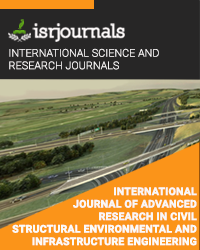fracture bheviour of amorphous microstructure concrete
SUDHARSAN.S V,Sibi rajan. r
Published in International Journal of Advanced Research in Civil,Structural,Environmental and Infrastructure Engineering and Developing
ISSN: 2320-723X Impact Factor:1.7 Volume:3 Issue:1 Year: 03 March,2017 Pages:301-305

Abstract
Safety is an essential concept of engineering design, and it tends to receive greater attention when the consequences of failure are severe. Every industry has its own safety requirement and guidelines to meet its own safety requirements, which includes protection of life and environment against possible hazards due to failures. The safety requirements for different industries vary from one another depending upon their functionality. Mechanical safety is one of the most important of all. Thus considerable steps have been taken in ensuring mechanical safety of the structural components. Usually, for mechanical safety, the design guidelines are based on stress computations and give importance to strength alone. However, concept of designing solely for strength, and using highest strength material without regard to fracture toughness is unreliable. These flaws are neglected by the conventional design approach hence they cannot be relied on all occasions. Hence the structure has to be designed considering the defects or flaws in structural components. Due to these flaws the component’s actual strength cannot be taken and new strength has to be found out for designing.
Kewords
Stress computation, Solely for Strength, Toughness, Flaws.
Reference
1. Al-Mukhtar M., Henkel S., Biermann H. and Hübner P. (2009), “A Finite Element Calculation of Stress Intensity Factors of Cruciform and Butt Welded Joints for Some Geometrical Parameters” JJMIE, Vol. 3, pp. 236 – 245 2. Bobiński J., Tejchman J. and Gorski J. (2009),”Notched concrete beams under bending – calculations of size effects within stochastic elasto-plasticity with non-local softening” International Journal of Non Linear Mechanics, Vol.61, pp 283-307 3. Chao Wang., Yamei Zhang and Zho zhao (2011), “A fracture process of rubberized concrete by fictitious crack model and AE monitoring” Computers and Concrete, Vol.9, pp 51-61 4. Dylmar Penteado Dias and Clelio Thaumaturgo.(2005), “Fracture toughness of geo-polymeric concretes reinforced with basalt fibers” Cement & Concrete Composites, Vol.27, pp. 49–54 5. Emilio Jiménez Piqué. (2002), “Fracture process zone of quasi brittle materials: a model material approach” Technische Universiteit Eindhoven Publishers, ISBN 90-386-2793-9. 6. Hardjito.D and B. V. Rangan (2005), “Development and Properties of Low- Calcium Fly ash based Geo-polymer Concrete”, Research Report GC-1, Faculty of Engineering,Curtin University of Technology,Perth, Australia. 7. Hardjito, D., and Rangan, B.V. (2005), “Development and Properties of Low Calcium Fly Ash-Based Geo-polymer Concrete”. Curtin University of Technology.

